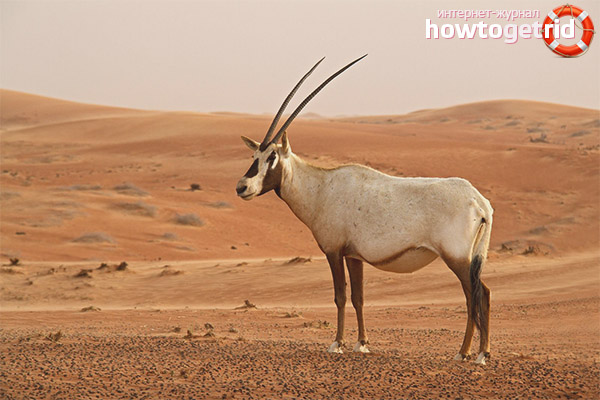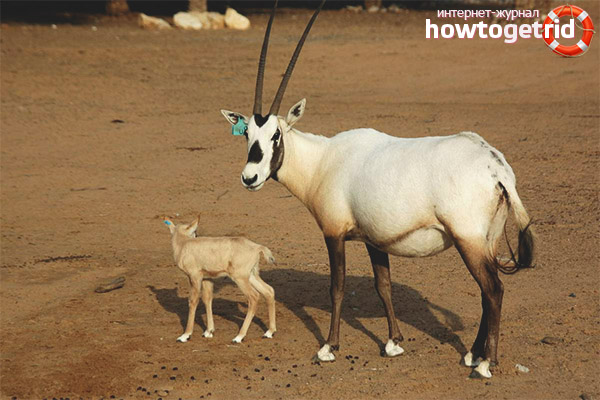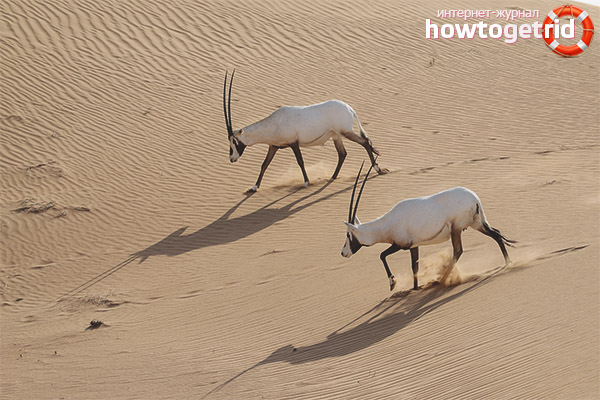The content of the article
Oryx arabian belongs to the family of bovids. There is a whole genus of Oriks, where the Arabian is one of the species. Representatives of this species have already completely disappeared. But recently, in Oman, scientists began to reintroduce this species. A special reserve was created in which animals were subsequently released.
After scientists were convinced that the experiments were successful, representatives of the species were also released on the territory of other countries. They are in Jordan, the United Arab Emirates, Israel, as well as Saudi Arabia. The best results were achieved in Israel, where animals breed successfully. The same success is observed in Saudi Arabia.
Appearance
Arabian oryxes are the smallest animals in comparison with other members of the genus. They weigh about 70 kg. Oryx height - 1 m.
They have a tail that is medium in length. The physique is rather slender and graceful. A distinctive feature is the long, almost straight horns, which are only slightly bent towards the back. Their length is approximately 65-70 cm. In females and males, they do not differ in length.
These animals have a snow-white skin, which makes it easier to tolerate the heat. But on the legs of the fur of these animals is black. To the base of the limbs, the color turns into brown. On the head of the oryx, several black marks are visible that form a “mask”.
Lifestyle
In these animals, the body is arranged in a special way, thanks to which they better tolerate hot weather. They have a network of capillaries, with the help of which the temperature of the blood can decrease. Excessive heat goes into the air.
Oriks are able to live without water for a long time. Every day they travel a long distance to find their food.
These animals have an amazing ability to sense moisture. For several kilometers, they can determine that there is a pond nearby, and go in this direction. They feel that in a particular area there will soon be precipitation, and move there. They are most active in the morning, and go into the shade during the day.
They feed on the few vegetation found in habitats. For relaxation, oryxes dig special holes for themselves. This is for them both shelter from the sun, and disguise.
Reproduction, social life
These animals almost never live alone. As a rule, they gather in herds, consisting of a small number of individuals. In such a herd, a clear hierarchy is respected. It consists of individuals of both sexes who have already reached the age of seven. If for some reason the herd is divided, then the males will return to the place where their group last stayed. And then the rest will join them.
Fact! Animal horns often serve as weapons to resolve conflicts between members of the herd.
The breeding season lasts all year. Every year, one baby is born in the female. The duration of pregnancy is 240 days. Most often, small oryxes are born from the beginning of October to the end of May.
By the age of 4 months, oryxes become independent. They themselves get food, and are not dependent on their mother. They reach puberty in 3 years. These animals live until about 20 years old.
Interesting Facts
It was the Arabian oryxes that prompted the ancient peoples to create the image of a unicorn in myths and legends. This image is present in the mythology of many countries. After all, they have the same white skin, and when viewed from the side you might think that the animal has only one horn on its head.
Even today, various mythical representations are associated with these animals. Nomadic Bedouins believe that oryxes have supernatural powers. They are sure that the person who can catch him will receive this power.
In scientific sources, the word "Oryx" was used by the Russian scientist Pallas. This name can be translated from the Greek language as "gazelle".
Security and strength
The history of this species proves that people are to blame for the extinction and decline in the majority of animals. Due to a careless attitude to nature and wanting to get profit, people often do not understand that they cause irreparable damage to nature.
Until the beginning of the 20th century, these animals were widespread throughout the Arabian Peninsula. Occasionally they were hunted by Bedouins. Many of them were afraid to go hunting in the wild and dangerous desert. Therefore, Onyxes rarely became victims of the Bedouins. But, when they started using cars during the hunt, this situation changed radically. In addition, the weapons of hunters have become more advanced. As a result, the extermination of these animals increased to dangerous proportions. Directly from the car, one hunter could shoot several oryxes at once. Previously, it was necessary to spend a lot of time and effort. Such active destruction of the species led to the fact that already in 1930 in the territory where Israel is located today, there were no oryks at all.
Already in 1972, the last individual was shot by hunters. Only a few zoos left a small number of these amazing inhabitants of the desert land.
Thanks to modern science, the species was still able to maintain and increase. In 1960, researchers began to worry about a sharp decline in the number of species. Immediately after that, a project was developed at the international level. It was called Oryx. The aim of this project was to create a permanent group that would successfully breed in captivity. Such a group was created in case the animals completely disappear.
In the 19th century, the species almost disappeared. Several groups lived in the southern part of the Arabian Peninsula, far from civilization.
The basis for creating a new generation of these animals was one female who lived in the zoo of the city of Phoenix, as well as two males. Already in 1980, researchers reintroduced representatives of the species into the wild. About 400 individuals were evicted to Oman.
Within a few years, the number has declined significantly. Only about 100 individuals left. Scientists did not lose hope, they began to breed animals in other places on the peninsula. It was possible to achieve that in some areas the number of species increases.
Today in the wild, there are approximately 1000 species. In addition, about 6,000 animals live in captivity. Such successes give hope that the species, almost destroyed by humanity, can be restored.
Already in 2011 there was an opportunity to review the status of the species. Previously, they were threatened with extinction, but now they are only a vulnerable species. This is an isolated case when a species that was previously destroyed in nature was transferred to this list. Such successes give hope that it will be possible to prevent the extinction of many other species of animals.
Video: Arabian Oryx (Oryx leucoryx)












Submit